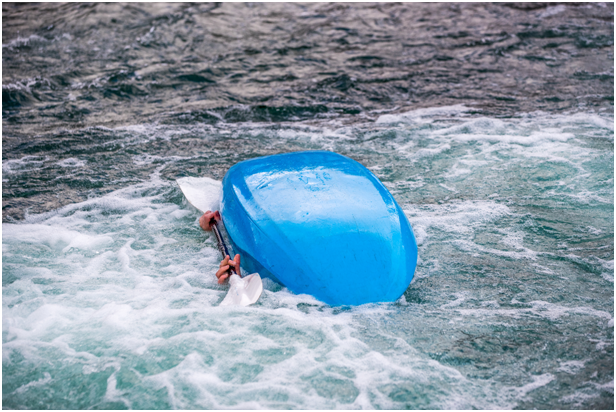Whitewater kayaking can be absolutely amazing …until you capsize. Suddenly,you’re upside down. Underwater. Rushing past rocks.
Even the most seasoned Hollywood stuntman would forgive you for panicking. But knowing how to roll your kayak can help you stay calm and get you back upright and breathing again.
The good news is, even beginner kayakers can learn to bombproof their rolls. Rolling in the rapids depends less on strength than a solid technique. Simply learn the steps and practice the sequence, and you too can master this essential safety maneuver.
But, first the basics…
Getting Comfortable Underwater
Synchronized swimmers can skip to the next section. Kayakers, pay attention.
To roll you must be comfortable underwater. Losing your cool in a rushing river can not only be dangerous, but deadly.
Start small…in a swimming pool or shallow body of water. With an instructor or friend standing by, flip over in your kayak. After a few seconds, have your buddy flip you back up. Build your confidence by repeating this process, extending your time underwater.
Maintain control of your paddle throughout the flip and remember to take a quick breath before going under.
Common White water Kayak Rolls
Once you’ve gotten comfortable kissing the fishes, it’s time to take the reins and roll on your own. There are more than a hundred types of rolls. Unless you plan on entering the Greenland National Kayaking Championship, however, it’s enough to know one or two well.
The two most commonly taught rolls are the “C to C roll” and “sweep roll”. They are similar but not the same, so which one you ultimately use is up to you. Both are beginner rolls, so once you become a more experienced paddler, it is likely you will create your own personal role you do by instinct.
As with the first step, practice in a pool or in calm, shallow water with a friend or instructor. They’ll be there to flip you upright in case you don’t get it right the first time.
Kayak Roll Setup
Both the C to CRoll and the Sweep Roll start from the same set-up position.
The side you set up on is determined by your power hand – your control (strong) arm should be forward. You move your body and paddle to this setup position while you are upside down under the water.
- Hold the paddle alongside (parallel to) the kayak, your forearms against the kayak, with the front blade flat against the surface of the water and its power face down against the water.
C to C Roll Procedure
The C to C roll unfolds underwater in two distinct steps, the paddle position, and the snap.
- The C to C Paddle Position
- Turn the paddle so that it is perpendicular to your kayak, with your front (power) arm away from the kayak.
- Brace your back arm against the kayak for leverage. (In this position, the paddle’s rear blade will be over your overturned kayak.)
- Keep the paddle as close to the water’s surface as possible
- The C to C Hip Snap
- Tuck your head and body forward and turn your body towards your paddle. This gets your body and head as close to the surface of the water as you can. The further you get your body towards your paddle and the side of the kayak, the easier it will be to get yourself back upright.
- NOTE: An important trick is turning your head to watch your paddle as you move it to the perpendicular position – this helps you rotate your body into the most powerful position.
- Pull downward on the front blade. When you feel it “hook” the right, use your hips (not your upper body) to rock, i.e. ‘snap,’ the boat upright.
- As you snap back upright, lean back a little to keep your center of gravity low.
Sweep Roll Procedure
The sweep roll is similar to the C to Croll, but it collapses the two-step technique into one fluid motion. Basically, instead of rotating your paddle 90 degrees and then pulling the blade into the water, you pull the blade into the water from the beginning in one continuous stroke.
Set-up for the sweep rolls the same way you do for the C to C roll.
- Sweep Roll Paddle Position
- Turn the paddle so that it is parallel to your kayak, with your front (power) arm away toward the front of the kayak.
- Instead of bracing your back arm against the kayak, keep it bent and near your chest to allow your power arm to sweep through the water better.
- Keep the paddle as close to the water’s surface as possible
- Sweep Roll Catch and Hip Snap
- Since your forearms are not braced against the kayak, you need to use your paddle for support.
- To achieve the support and roll leverage, pull your paddle through the water in a wider arc.
- Keeping your paddle near the surface throughout the sweep move is important – but difficult.
- The best way to achieve this is to set your paddle at a moderate climbing angle, meaning the leading edge of your paddle is higher (closer to the sky) than the back edge.
- Your arms should stay somewhat fixed – your torso should drive your paddle through the water. Again, the best way to achieve the proper power of the drive is to watch your paddle as you sweep it through the water.
- As you reach the most powerful part of the sweep, rotate your torso and hip snap the boat upright.
- It is very important to get your hips and torso above water first. Your head should be the last part of your body that returns to position. If you lift your head too soon, it is likely that you won’t get back upright and will end up capsized again.
- The key to the sweep roll is to complete it in a single step.
I’m Still Underwater
If you’re still upside down – you’re following the steps, but the practice hasn’t made perfect– try tweaking your technique with the following tips:
- Slow Your Roll. No one can blame you for wanting to breathe again. But rolling too fast can weaken your torso rotation, which is key to getting yourself upright.
- Don’t Use Your Head. Again, when completing a roll your head should be the LAST part of your body, not the first, to emerge from the water. Getting your torso’s bodyweight above water is critical to a successful roll. Pull your head up too soon and you’ll roll right back under.
Which Whitewater Kayak Roll to Use: C to C Roll or Sweep Roll?
Which role you use is entirely up to you. Chances are, over time and with experience, your role will evolve into a move that’s uniquely yours.
Most whitewater kayakers wear by the sweep roll. It’s faster, allowing for a quicker recovery, which can be crucial in a fast-moving river.
Before you pack up the SUV however, make sure that you’ve practiced and perfected your roll. By the time you take on Mother Nature, your roll should be muscle memory.
But I Don’t Wanna Practice!

If you are going to kayak, you will encounter a situation where you need to roll. If you’re ever going to roll successfully (and live for the next whitewater run), you must put in the practice period.
Get motivated by making each session count. Work with an instructor, if possible. They can give you real-world tips from years of experience while solidifying your fundamentals. Getting the fundamentals right will prevent bad form (and frustration – or worse – down the road).
Wear nose plugs. While your look might not make the cover of Paddling Magazine, it’s no fun learning to roll with water rushing up your nose.
Dress to get dunked. Leave the tiny swimsuit or shirts that will take on heavy water at home. Wear a dry suit or dry top to withstand repeated underwater immersion. And don’t forget your PFD.
Know How to “Wet Exit” a Kayak
Just like every fighter pilot knows where to find the “Eject” button, every kayaker should know how to “wet exit”. When a roll goes wrong, a “wet exit” gets you out of your kayak and back up to the surface.
In whitewater conditions, wet exiting can expose you to underwater hazards, naturally. Rolling your capsized kayak is the preferred recovery method. But if you’re stuck underwater with no way out, a wet exit can help you get to safety.
Wet Exit Procedure
- Lean forward in the kayak.
- While gripping your paddle with one hand, slide your free hand forward along the cockpit coaming until you feel the grab loop. (NOTE: It’s important to make sure the grab loop is outside the spray skirt before you set out.)
- Grab the loop and pull up. This will release the spray skirt from the coaming.
- Once the spray skirt is fully detached from the coaming, brace your hands against the cockpit. Using your legs, push yourself out of the boat.
By practicing and perfecting your rolls before you get in the water, you not only will increase your success rates, you will greatly enhance your enjoyment of one of the world’s most exhilarating activities.

Share your thoughts